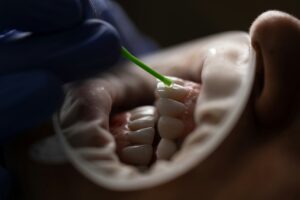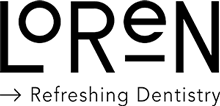
Table of Contents
- Key Points
- Understanding Teeth Whitening
- At-Home Teeth Whitening
- In-Office Dental Whitening
- Key Differences Between At-Home and In-Office Whitening
- Which Option Is Right for You?
- Tips for Maintaining a Whiter Smile
- Get Further Advice on At-Home and In-Office Teeth Whitening Treatment
- References
Key Points
- There are many teeth whitening options to choose from, but the two main categories are those administered at a dentist’s office and at-home, over-the-counter treatments.
- There are different advantages to each, along with a few drawbacks.
- Understanding the distinctions between the types of treatments can help patients make a more informed decision about which is best for them.
A bright, white smile is often associated with confidence and good oral hygiene. For this reason, teeth whitening has become one of the most sought-after cosmetic dental treatments, offering solutions for discoloration caused by aging, diet, or lifestyle. According to the American Dental Association, close to one in five Americans have had the procedure.1
Due to this popularity, at-home teeth whitening products have exploded in the last decade or so, with dozens of options to choose from. These offer convenience, among other advantages, but often do not stack up to the effectiveness of dental office whitening.
As someone who has witnessed the evolution of teeth whitening techniques and technologies over the decades, and advised thousands of patients on the process, I know this information can get complex. Below, I have broken down the distinct advantages and disadvantages of both at-home and in-office teeth whitening treatments.
Understanding Teeth Whitening
Teeth whitening is a cosmetic dental procedure that works by removing stains and discoloration from the enamel (the outer layer of the teeth). The most common whitening agents are hydrogen peroxide or carbamide peroxide, which break down stains into smaller molecules, making them less visible.2
There are two types of teeth whitening methods:
- Extrinsic Whitening: Targets surface stains caused by coffee, tea, wine, or smoking.
- Intrinsic Whitening: Targets deeper stains within the tooth structure.
At-Home Teeth Whitening
At-home teeth whitening products are widely available and range from over-the-counter solutions to custom trays provided by your dentist. Below are the most common types.
1. Whitening Toothpaste
Certain toothpastes contain mild abrasives like baking soda or silica to remove surface stains, thereby whitening teeth. Some tooth-whitening toothpastes also include hydrogen peroxide for mild teeth-bleaching effects.
- Cost: $5–$30 per tube.
- Pros:
- Affordable and easy to use.
- Helps maintain results after other whitening treatments.
- Some formulations (like hydroxyapatite toothpaste) can strengthen enamel and prevent tooth decay, while whitening.3
- Cons:
- Limited effectiveness on intrinsic stains.
- Prolonged use of abrasive formulas may damage tooth enamel.
2. Whitening Strips
Whitening strips are thin, flexible plastic strips coated with a peroxide-based gel. They are applied directly to the teeth for a specified duration.
- Cost: $13–$60 per box.
- Pros:
- Convenient and accessible.
- Results can appear within days or weeks.
- Some brands are approved by the American Dental Association.
- Cons:
- May cause gum irritation or tooth sensitivity.
- If not applied properly, can produce uneven results.
3. Custom Whitening Trays
Custom-fitted trays are provided by dentists and filled with a peroxide gel for at-home use.
- Cost: $250–$500 for trays; $20–$40 per gel refill.
- Pros:
- Offers professional-level results at home.
- Protects gums from irritation due to the custom fit.
- Can be reused for maintenance.
- Cons:
- Requires initial dental visits for fitting.
- Higher cost compared to other at-home options.
4. Whitening Pens
Whitening pens contain a gel that is applied directly to the teeth using a brush applicator.
- Cost: $20–$40 per pen.
- Pros:
- Portable and easy to use.
- Ideal for touch-ups or minor whitening needs.
- Cons:
- Limited effectiveness on stubborn stains.
- Results may take longer to appear than most other products.
In-Office Dental Whitening
Professional teeth whitening offers the quickest, most dramatic, and longest-lasting results. The procedure typically involves applying a high-concentration peroxide gel to the teeth, often activated by a special light or laser.
Advantages of In-Office Whitening
- Immediate Results: In-office treatments can whiten teeth by several shades in just one session.
- Safety and Supervision: The procedure is carefully monitored by dental professionals to minimize risks like gum irritation or tooth sensitivity.
- Customizable Treatment: Dentists can tailor the treatment based on the severity of discoloration and your specific needs.
Disadvantages of In-Office Whitening
- Cost: The average price ranges from $300 to $650 per session, making it more expensive than at-home alternatives. (Keep in mind that this is if you are paying the entire cost out-of-pocket.)
- Temporary Results: While highly effective, in-office whitening is not permanent. Maintenance with at-home products or follow-up visits is often required.
- Minor Potential Discomfort: Although modern techniques reduce sensitivity risks, some patients may still experience temporary discomfort or tooth sensitivity during or after treatment.
Popular In-Office Whitening Systems
- Zoom! Whitening: Uses a blue LED light to activate the bleaching gel, offering quick and noticeable results in about an hour. (This is the method our office prefers—I believe it offers the fastest, most impactful results.)
- Opalescence Boost: A chemically activated gel that does not require light activation, designed to reduce sensitivity while delivering effective results.
Key Differences Between At-Home and In-Office Whitening
Which Option Is Right for You?
The choice between at-home and in-office teeth whitening depends on several factors:
- Severity of Stains: Deep intrinsic stains often require professional intervention, while surface stains can be addressed with at-home products.
- Sensitivity Concerns: Individuals with sensitive teeth may benefit from dentist-supervised treatments that use desensitizing agents like potassium nitrate or fluoride, for a more comfortable patient experience.
- Time Constraints: For those seeking immediate results, in-office treatments are preferable.
- Budget: If cost is a concern, at-home options like whitening toothpaste or strips may be more suitable. Custom trays could offer a balance between affordability and effectiveness. Also, some dentist offices, like ours, offer financing options for whitening treatments.
Tips for Maintaining a Whiter Smile
Regardless of the method you choose, maintaining your results requires consistent oral hygiene and lifestyle adjustments:
- Brush twice daily with fluoride toothpaste to prevent new stains.
- Avoid or limit foods, like coffee and red wine, that tend to stain teeth.
- Use a straw when consuming dark beverages to minimize contact with teeth.
- Schedule regular dental cleanings to remove plaque buildup.
Get Further Advice on At-Home and In-Office Teeth Whitening Treatment
Both at-home and dentist-administered teeth whitening have their advantages and drawbacks. At-home solutions are cost-effective and convenient, but will take longer to produce noticeable results. In contrast, professional whitening delivers immediate and dramatic improvements under expert supervision but comes at a higher cost.
Consulting with your dentist is the best way to determine which options align with your budget, timeline, and oral health goals. At Loren Dental, we offer a variety of high-quality cosmetic dental services in Raleigh NC, including teeth whitening treatment. Our in-office therapy is $300, which includes a mini take-home kit to help accelerate and prolong results. We also offer add-on options, like the Glo teeth whitening home package, for even more pronounced outcomes. Reach out to us today to discuss teeth-whitening options or schedule an appointment.
References
- “Cosmetic Teeth Whitening May Be More Popular Than Ever,” ADA News, The American Dental Association, December 2024, https://adanews.ada.org/huddles/cosmetic-teeth-whitening-may-be-more-popular-than-ever/.
- Yasmin M. Asaad, Sultan T. Alshammari, Ahlam M. S. Faloudah, et al., “Efficacy and Safety of Carbamide Peroxide Tooth-Whitening Gels,” International Journal of Community Medicine and Public Health, January 2023, https://www.ijcmph.com/index.php/ijcmph/article/view/10840/6458.
- Kelsey O’Hagan-Wong, Joachim Enax, Frederic Meyer, and Bernhard Ganss, “The Use of Hydroxyapatite Toothpaste to Prevent Dental Caries,” Odontology, November 2021, https://pmc.ncbi.nlm.nih.gov/articles/PMC8930857/.

Dr. Brett Wells is the founder of Loren Dental, DentalHQ.com, and Wells Family Dental Group, which was recently awarded the Triangle Business Journal’s “2024 Best Places to Work” recognition. Dr. Wells has more than 20 years of experience practicing general and family dentistry, and has published widely in major medical journals, like Dental Economics and Inside Dentistry, on topics ranging from navigating dental insurance to advice for other dental practices and the impact of PPOs on dentistry. He is a graduate of the University of North Carolina-Chapel Hill Adams School of Dentistry and maintains memberships in various professional associations, including the American Dental Association, the Academy of General Dentistry, and the Dentist Entrepreneur Organization.
